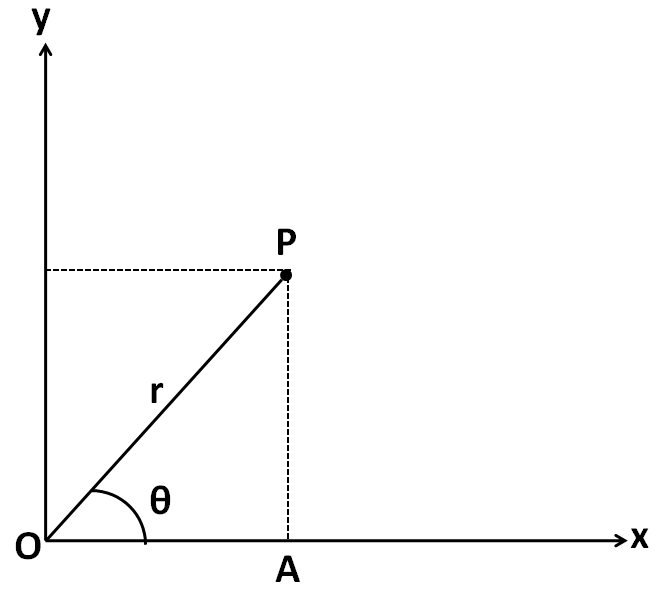
How do you convert $r\cos \left( \theta \right)=4$ into rectangular form?
Answer
541.5k+ views
Hint: A complex number in the polar form is represented in terms of the distance from the origin, $r$ and the angle made with the x-axis, $\theta $. And in the rectangular form it is represented in the form of the rectangular coordinates, x and y. Considering a complex number in the x-y plane we can determine the relation between its polar and the rectangular coordinates. On substituting the relation into the given equation $r\cos \left( \theta \right)=4$, we can write the required rectangular form.
Complete step by step answer:
In the above question, we have been given a complex number in the polar form. We know that a complex number can be represented in two forms, which are the polar form and the rectangular form. In the polar form, we represent a complex number by its two parameters; first one is its distance from the origin, $r$ and the second one is the angle made by it with the positive direction of the x axis, $\theta $. While in the rectangular form, the complex number is represented in the form of its polar coordinates; $x$ and $y$.
Consider a complex number represented by a point P in the x-y plane as shown in the figure below.

For representing it in the rectangular form, we need to determine its x and y coordinates. In the triangle OAP, we have
$\begin{align}
& \Rightarrow \cos \theta =\dfrac{OA}{OP} \\
& \Rightarrow \cos \theta =\dfrac{OA}{r} \\
\end{align}$
Multiplying both sides by $r$ we get
$\Rightarrow OA=r\cos \theta $
From the above figure, the x-coordinate of the point P is equal to $OA$. SO we have
$\Rightarrow x=r\cos \theta .........(i)$
Similarly we have
$\begin{align}
& \Rightarrow \sin \theta =\dfrac{PA}{OP} \\
& \Rightarrow \sin \theta =\dfrac{PA}{r} \\
& \Rightarrow PA=r\sin \theta \\
& \Rightarrow y=r\sin \theta ........(ii) \\
\end{align}$
Equations (i) and (ii) together are the required relations between the polar and the rectangular coordinates of the complex number.
Now, in the given question we have
$r\cos \left( \theta \right)=4$
Substituting (i) in the above equation, we get
$\begin{align}
& \Rightarrow r\left( \dfrac{x}{r} \right)=4 \\
& \Rightarrow x=4 \\
\end{align}$
This is the required rectangular form of $r\cos \left( \theta \right)=4$.
Note: In the above question, we had no information regarding the y-coordinate of the complex number. This occurred because in the polar form we have two variables, $r$ and $\theta $. But we were given only a single equation, that is $r\cos \left( \theta \right)=4$. So we could only determine the x-coordinate of the complex number. Otherwise, in the rectangular form the complex number is written as $x+iy$.
Complete step by step answer:
In the above question, we have been given a complex number in the polar form. We know that a complex number can be represented in two forms, which are the polar form and the rectangular form. In the polar form, we represent a complex number by its two parameters; first one is its distance from the origin, $r$ and the second one is the angle made by it with the positive direction of the x axis, $\theta $. While in the rectangular form, the complex number is represented in the form of its polar coordinates; $x$ and $y$.
Consider a complex number represented by a point P in the x-y plane as shown in the figure below.

For representing it in the rectangular form, we need to determine its x and y coordinates. In the triangle OAP, we have
$\begin{align}
& \Rightarrow \cos \theta =\dfrac{OA}{OP} \\
& \Rightarrow \cos \theta =\dfrac{OA}{r} \\
\end{align}$
Multiplying both sides by $r$ we get
$\Rightarrow OA=r\cos \theta $
From the above figure, the x-coordinate of the point P is equal to $OA$. SO we have
$\Rightarrow x=r\cos \theta .........(i)$
Similarly we have
$\begin{align}
& \Rightarrow \sin \theta =\dfrac{PA}{OP} \\
& \Rightarrow \sin \theta =\dfrac{PA}{r} \\
& \Rightarrow PA=r\sin \theta \\
& \Rightarrow y=r\sin \theta ........(ii) \\
\end{align}$
Equations (i) and (ii) together are the required relations between the polar and the rectangular coordinates of the complex number.
Now, in the given question we have
$r\cos \left( \theta \right)=4$
Substituting (i) in the above equation, we get
$\begin{align}
& \Rightarrow r\left( \dfrac{x}{r} \right)=4 \\
& \Rightarrow x=4 \\
\end{align}$
This is the required rectangular form of $r\cos \left( \theta \right)=4$.
Note: In the above question, we had no information regarding the y-coordinate of the complex number. This occurred because in the polar form we have two variables, $r$ and $\theta $. But we were given only a single equation, that is $r\cos \left( \theta \right)=4$. So we could only determine the x-coordinate of the complex number. Otherwise, in the rectangular form the complex number is written as $x+iy$.
Recently Updated Pages
Master Class 8 Maths: Engaging Questions & Answers for Success

Class 8 Question and Answer - Your Ultimate Solutions Guide

Master Class 7 Maths: Engaging Questions & Answers for Success

Class 7 Question and Answer - Your Ultimate Solutions Guide

Master Class 6 Maths: Engaging Questions & Answers for Success

Class 6 Question and Answer - Your Ultimate Solutions Guide

Trending doubts
What is meant by exothermic and endothermic reactions class 11 chemistry CBSE

Which animal has three hearts class 11 biology CBSE

10 examples of friction in our daily life

One Metric ton is equal to kg A 10000 B 1000 C 100 class 11 physics CBSE

1 Quintal is equal to a 110 kg b 10 kg c 100kg d 1000 class 11 physics CBSE

Difference Between Prokaryotic Cells and Eukaryotic Cells




